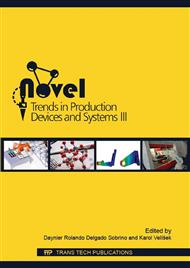[1]
A. Z. Sultan, S. Sharif, D. Kurniawan, Effect of Machining Parameters on Tool Wear and Hole Quality of AISI 316L Stainless Steel in Conventional Drilling, Procedia Manufacturing. 2 (2015) 202 – 207.
DOI: 10.1016/j.promfg.2015.07.035
Google Scholar
[2]
J. Prasanna et al., Optimization of process parameters of small hole dry drilling in Ti–6Al–4V using Taguchi and grey relational analysis, Measurement. 48 (2014) 346–354.
DOI: 10.1016/j.measurement.2013.11.020
Google Scholar
[3]
S. R. Fernandéz-Vidal et al., Analysis of the effects of tool wear on dry helical milling of Ti6Al4V alloy, Procedia Engineering. 132 (2015) 593 – 599.
DOI: 10.1016/j.proeng.2015.12.536
Google Scholar
[4]
S. Sun, M. Brandt, M. S. Dargush, Characteristics of cutting forces and chip formation in machining of titanium alloys, International Journal of Machine Tools & Manufacture. 49 (2009) 561–568.
DOI: 10.1016/j.ijmachtools.2009.02.008
Google Scholar
[5]
J. Kundrak, G. Varga, I. Deszpoth, V. Molnar, Some aspects of the hard machining of bore holes (2013) Applied Mechanics and Materials, 309, pp.126-132.
DOI: 10.4028/www.scientific.net/amm.309.126
Google Scholar
[6]
L. Kandráč et al., Application of FEM analysis to predict the effect of cutting conditions and tool geometry on temperature and cutting forces during orthogonal cutting of Ti-6Al-4V, Development in Machining Technology : Scientific Research Reports. 4 (2014).
DOI: 10.4028/www.scientific.net/amm.474.192
Google Scholar
[7]
F. A. Almeida et al., Machining hardmetal with CVD diamond direct coated ceramic tools: effect of tool edge geometry, Diamond & Related Materials. 14 (2005) 651–656.
DOI: 10.1016/j.diamond.2004.09.002
Google Scholar
[8]
B. Denkena et al., Influence of the cutting edge preparation method on characteristics and performance of PVD coated carbide inserts in hard turning, Surface & Coatings Technology. 254 (2014) 447–454.
DOI: 10.1016/j.surfcoat.2014.07.003
Google Scholar
[9]
C. E. H. Ventura, J. Kohler, B. Denkena, Cutting edge preparation of PCBN inserts by means of grinding and its application in hard turning, CIRP Journal of Manufacturing Science and Technology. 6 (2013) 246–253.
DOI: 10.1016/j.cirpj.2013.07.005
Google Scholar
[10]
B. Denkena, D. Bierman, Cutting edge geometries, CIRP Annals - Manufacturing Technology. 63 (2014) 631–653.
DOI: 10.1016/j.cirp.2014.05.009
Google Scholar
[11]
P. F. Zhang, N. J. Churi, Z. J. Pei, C. Treadwell, Mechanical drilling process for titanium alloys: A literature review, Machining Science and Technology. 14 (2008) 417-444.
DOI: 10.1080/10910340802519379
Google Scholar
[12]
D. Kim, M. Ramulu, Cutting and drilling characteristics of hybrid titanium composite laminate (HTCL), Proceedings of Materials and Processing Technologies for Revolutionary Applications Fall Technical Conference. (2005a) 1-8.
Google Scholar
[13]
. N. Khanna, J. P. Davim, Design-of-experiments application in machining titanium alloys for aerospace structural components, Measurement. 61 (2015) 280–290.
DOI: 10.1016/j.measurement.2014.10.059
Google Scholar
[14]
B. Karpuschewski et al., Measuring procedures of cutting edge preparation when hard turning with coated ceramics tool inserts, Measurement. 55 (2014) 627–640.
DOI: 10.1016/j.measurement.2014.06.008
Google Scholar
[15]
S. Y. Hong, I. Markus, W. Jeong, New cooling approach and tool life improvement in cryogenic machining of titanium alloy Ti-6Al-4V, International Journal of Machine Tools & Manufacture. 41 (2001) 2245–2260.
DOI: 10.1016/s0890-6955(01)00041-4
Google Scholar
[16]
Kivak, G. Samtas, A. Cicek, Taguchi method based optimisation of drilling parameters in drilling of AISI 316 steel with PVD monolayer and multilayer coated HSS drills, Measurement. 45 (2012) 1547–1557.
DOI: 10.1016/j.measurement.2012.02.022
Google Scholar
[17]
T. Ozel, M. Sima, A. K. Srivastava, B. Kaftanoglu, Investigations on the effects of multi-layered coated inserts in machining Ti–6Al–4V alloy with experiments and finite element simulations, , CIRP Annals - Manufacturing Technology. 59 (2010).
DOI: 10.1016/j.cirp.2010.03.055
Google Scholar
[18]
Tsann-Rong Lin, Experimental design and performance analysis of TiN-coated carbide tool in face milling stainless steel, Journal of Material Processing Technology. 127 (2002) 1-7.
DOI: 10.1016/s0924-0136(02)00026-2
Google Scholar
[19]
V. Bana, B. Karpuschewski, J. Kundrák, A. M. Hoogstrate,. Thermal distortions in the machining of small bores. (2007) Journal of Materials Processing Technology, 191 (1-3), pp.335-338.
DOI: 10.1016/j.jmatprotec.2007.03.027
Google Scholar


